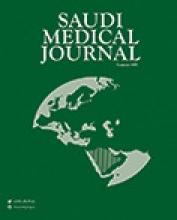Abstract
OBJECTIVE: To provide normative data on maximal cardiorespiratory function for healthy Saudi boys between the ages of 7-15 years.
METHODS: One hundred and thirty-seven Saudi boys from nearby schools in Riyadh, Kingdom of Saudi Arabia, participated in this study. Cardiorespiratory measurements were obtained during graded treadmill running until exhaustion. Gas exchange variables were assessed continuously throughout the test using open circuit spirometry.
RESULTS: Normative values in the forms of means, standard deviation and percentiles were presented for 4 age groups. Mass-dependent cardiorespiratory variables were also classified based on body surface area. Absolute maximal oxygen uptake increased linearly from 1.2 ± 0.2 L.min-1 at age 7-9 years to 2.5 ± 0.5 L.min-1 at age 13-15 years. Maximal oxygen uptake relative to body mass (ml.kg.-1 min-1) or relative to lean body mass (ml.kg.-1 lean body mass min-1) did not show any appreciable changes across ages. Mass-dependent variables such as pulmonary ventilation (L.min-1), tidal volume, and oxygen pulse (oxygen uptake/heart rate) also exhibited a linear increase with age, reflecting strong associations with body size indices (body mass, height and lean body mass). Maximal heart rate during childhood and adolescence appears to be independent of age. Ventilatory anaerobic threshold as a percentage of maximal oxygen uptake ranged from 66% for the younger to 77% for the older age groups.
CONCLUSION: Maximal oxygen uptake expressed relative to body surface area or scaled to body mass to the power of 0.75 or 0.67 appears to provide a more appropriate means of expressing changes in maximal oxygen uptake across ages in children and adolescents. Further, maximal pulse index (oxygen pulse/body surface area) seems to control for the strong association of oxygen pulse with the body size during growth.
- Copyright: © Saudi Medical Journal
This is an open-access article distributed under the terms of the Creative Commons Attribution-Noncommercial-Share Alike 3.0 Unported, which permits unrestricted use, distribution, and reproduction in any medium, provided the original work is properly cited.






